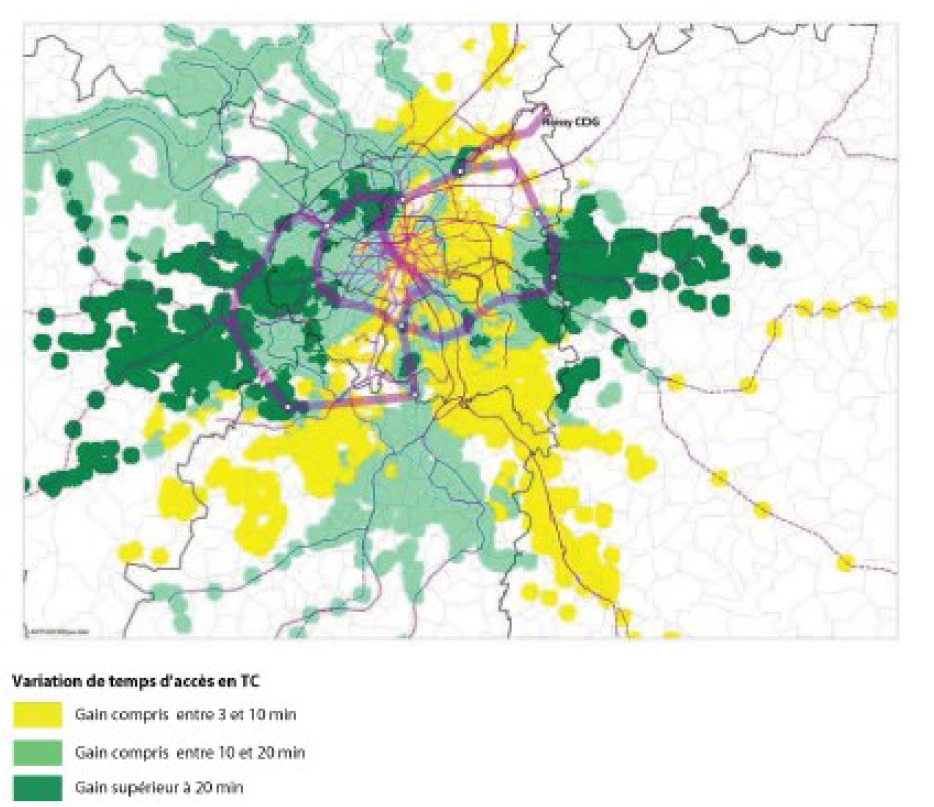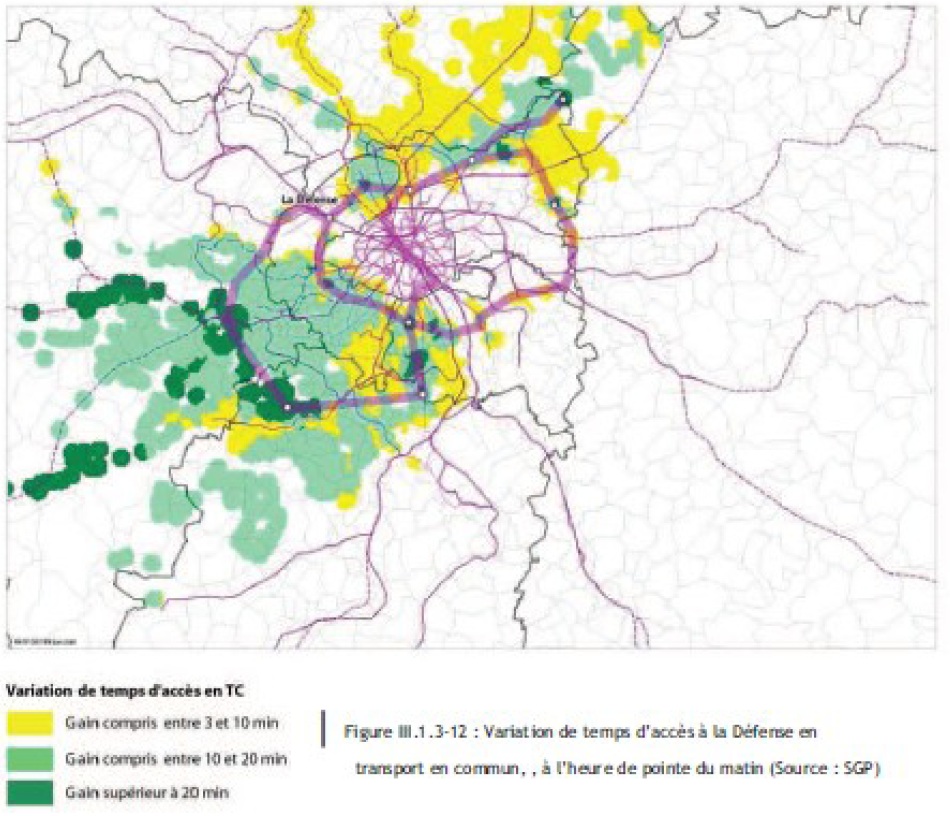According to Jean-Paul Lacaze, as the displacements of people going from a suburban town to another
town located in the suburbs keep increasing, the transportation project proposed by the government
and the region will not be big enough to please the demand of all the inhabitants of Paris Ile-de-
France. Indeed, the “Grand Huit” would be too slow to be efficient, if it would have to stop to all the
stations in the “circle”.
Jean-Paul Lacaze even considers an extra investment would be needed in addition to the 35 billion
requested for the new public transport project, in order to support the existing framework of transports,
as many lines are saturated(104). We could analyze this as an important threat to the business health of
Paris (if the addition of new infrastructures can generate an economic growth, the existing
transportation inefficiency can destroy some of the wealth). According to Marcel Belliot, the
renovation of the existing infrastructures would cost €18 million, and ask if there is a real necessity to
create such a big transportation system (“Grand Huit”). Its financing will certainly be prioritized
compare to the other projects (CDG express linking Paris CDG airport to the city centre), and could
delay their realizations (or could even be abandoned). The author also criticizes the fact that the
financing of this transport creation is still not clear(105).
Indeed this project brings a lot of hopes from the users, because of their conditions of living. Philippe
Panerai concluded its work “Paris Métrople. Formes et échelles du Grand Paris”, by assuming: the
future vision of a Greater Paris more fair and unified, would depend of the plan of the public
transports”(106).
Nevertheless, this project could still have a significant impact on the Parisian companies’ results.
Indeed, as we have seen, this project would be based on the objective to link (so to accelerate) the
connections between the places located “far away” from each other to provide a closeness of these
areas. According to Ascher, the long distance between stations creates a quantum tunneling, which
creates proximity between the different economic centers linked, which is an important impact on the
good expansion of the companies(107).
As previously seen, the project will lead to an important reduction of the journey, in order to show the
impact on the Parisian companies, the two following maps show the gain to go to two important
economic centers Paris CDG Airport and La Défense :
(108) Figure 11: Time gained to go to Paris CDG airport

When looking at this map, we can realize how important will be the journey reduction to go to the
main international airport of Paris. Indeed, from the city centre the time saved to reach the Paris CDG
will be reduced by 3 to 10 minutes, while the gain of time from La Défense business district will be
between 10 and 20 minutes.
The project aims to close the airport to the business district by reducing the time, in order to facilitate
international business displacements.
(109) Figure 12:Time gained to go to La Défense Business district

In 1998, Berion concluded its research by the fact that public transports infrastructure cannot generate
an economic growth as a single factor. Nevertheless it is still a major economic development
system(110).
Indeed according to Banister and Berechmann (2001), transit infrastructures investments would have
only a positive impact if three factors are operational(111):
– Presence of positive economic externalities: labour market, quality of the labour market,
dynamism of the economy.
– Investment factors: money available for the transportation investment and the effects of
transport network.
– The politic aspect: economic policies, institutional aspect.
Berion also assumes that the metropolisation of a territory (which corresponds to our present case)
needs a densification of the infrastructures in the key area(112).
Many studies have shown the correlation between the GDP and the mobility within the region. Indeed
it generates new needs of displacement to the population, the governments have to support this growth
and answer to the transport users by creating new lines adapted to the needs. The mobility growth has
a direct impact on the transportation demand, which will lead to the development of new services.
According to Oeil-CEBR in 1994, in urban environments, the labour force availability does not only
depend of the population density, but also of the time the workforce needs to go to work. This
assumption permits us we to link the economic benefits of the public transports densification of Paris
on the labour market(113).
Some researchers also demonstrated that a public investment in transportation would improve the
quality of life of the inhabitants, by reducing the time required to reach a destination, and also by
increasing their property holdings value due to the implementation of new stations(114).
104 Jean-Paul Lacaze « Le fait du prince ? », revue urbanisme, Octobre 2009, P.P 69
105 Marcel Belliot, « Le Grand Paris des illusions », revue urbanisme, Octobre 2009, P.P 64
106 Philippe Panerai, « Paris Métropole », Edition de La Villette, Aout 2008, P.P.103-107
107 François Ascher, La République contre la ville, 2000, P.P 119
108 Débat publique Grand Paris, Evolution stratégique environnementale du réseau de métro automatique de
109 Débat publique Grand Paris, Evolution stratégique environnementale du réseau de métro automatique de
Paris, 2010, P.P 49
110 Pascal Berion, « Analyser les mobilités et les rayonnements des villes pour révéler les effets territoriaux des
grandes infrastructures de transport », les cahiers Scientifiques du Transport, n°33, 1998, P.P. 125-126.
111 Banister, D., & Berechmann, Y. (2001). Transport investment and the promotion of economic growth.
Journal of Transport Geography 9, 209-218.
112 Ibid, P.P 117
113 Sourced by Juan Pablo Bocajero, « Evaluation économique de l’impact des politiques publiques liées à la
mobilité, le cas de Paris, Londres, Bogota et Santiago », Université Paris Est, 2008, P.P 36
114 Saurav Dev Bhatta, Matthew P. Drennan, “The Economic Benefits of Public investment in Transportation”,
P.P.289
Page suivante : D-c Logistic projects to export
Retour au menu : LE GRAND PARIS How would this project generate an economic growth?
